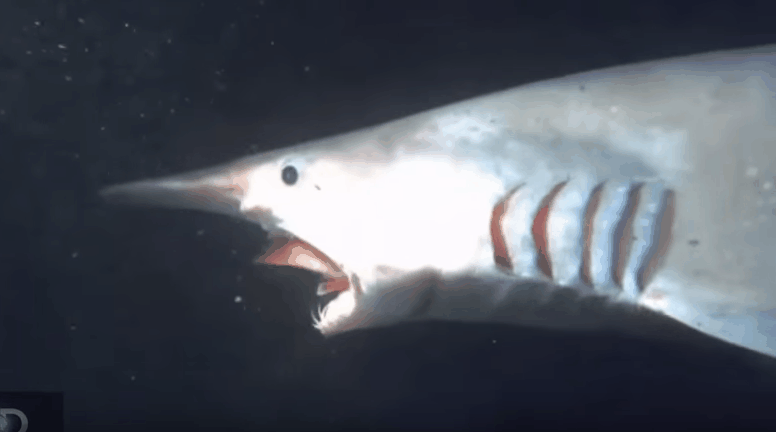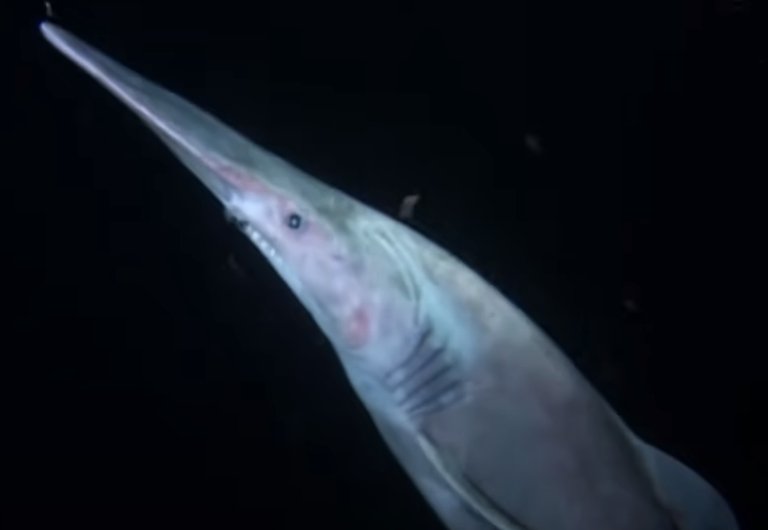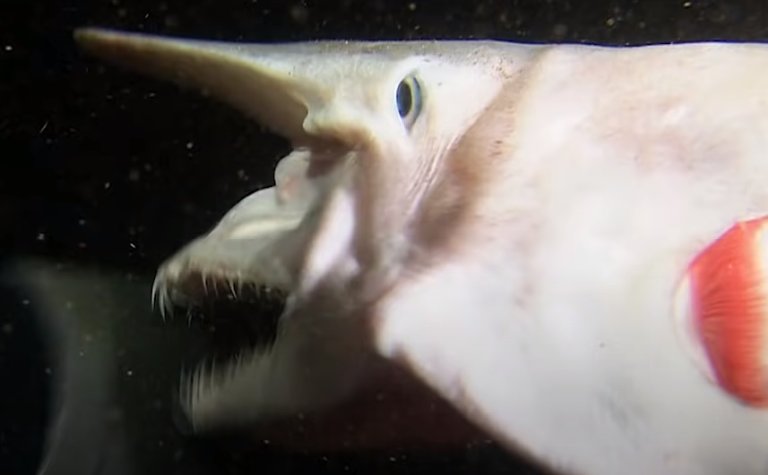Goblin Shark Profile
Sharks are one of the most enigmatic and alluring groups of animals on earth, and most come with hidden secrets, the likes of which we’ll never fully explore. Deepwater sharks take this to new levels, and some of these are so elusive that they’re almost legendary.
Living well over a kilometre down, goblin sharks closely guard anything that might give us a clue as to who they are and what they want.
The shark has a pink skin and a very distinct profile that features an elongated, flattened snout. Within it are protruding jaws, that are filled with teeth that resemble nails.

Goblin Shark Facts Overview
| Habitat: | Deep-sea |
| Location: | Atlantic, Pacific & Indian Oceans. But most commonly found off the coasts of Japan. |
| Lifespan: | 30 – 35 Years |
| Size: | 9.8 – 20 ft (3 to 6 m) |
| Weight: | 330 – 460 pounds (150 – 210 kg) |
| Color: | Pink, tan and almost white grey |
| Diet: | Fish, such as rattails and dragonfishes as well as cephalopods and crustaceans. |
| Predators: | Other sharks (like the blue shark) |
| Top Speed: | 20 kph (15 mph) |
| No. of Species: |
1 |
| Conservation Status: |
Least concern |
Goblin sharks are one of these legends. Their bizarre appearance, their propensity for showing up at seemingly random places all over the globe, their colour, their skin, everything about these sharks makes them something that maybe shouldn’t exist.
But they do, and they’re living fossils from well over a hundred million years ago. It comes from the Mitsukurinidae family and the goblin shark happens to be the only extant representative of that family.
But what looks like it should hinder the animal turns out to be a very deliberate and beneficial approach to a hostile and difficult habitat.
A lot remains to be known about these sharks, but researchers are slowly piecing the puzzle together, to learn more about this almost mythical fish.
Interesting Goblin Shark Facts
1. They’re pink!
Of all the colours you’d associate with a goblin, I bet pink wasn’t one of them. However, this colour goes come from a trait that’s much more in line with a mythical demon from the middle ages.
Goblin sharks have wrinkled, translucent skin, and through this, it’s their blood that gives them a murky, pink or purplish-grey tinge.
That’s not nearly the only thing that gives these sharks their name, however…

2. They grow into their noses
When they’re little, they’re equipped with disproportionately huge noses. While they never fully reach healthy proportions, this nose doesn’t grow as fast as the shark’s body does, so it does start to look a little better on them.
Still, these are some ugly fish. With the weird jaws and the wrinkly skin, the oversized schnoz doesn’t do them any favours in the looks department.
Fortunately for the shark, it’s very dark in the deep, and the nose is packed with an array of electroreceptors called ampullae of Lorenzini that help it identify tiny little heartbeats of tiny little food items in the inky blackness. 1
3. They have atrophied bodies
These sharks seem to have small fins, weak skeletons, and poorly-developed muscular and visual systems. Indeed, most of what we might consider useful adaptions in an animal are missing from this one.
And yet, it is supremely well adapted. This shark has been living in the deep ocean, relatively unchanged for over 125 million years.
Along with its heartbeat-detecting snout, the goblin shark has rapidly-extendible jaws that attach to an expandable, muscular mouth and throat. The ugly, ragged teeth are also not as haphazard as they seem. They’re perfect for impaling deep-sea, slippery fish.
4. They’re probably ambush predators
These adaptations suggest that the best way for this shark to hunt is to quietly approach prey in the dark and rapidly lunge at it with open jaws.
From studying the jaws specifically, it seems that they’re able to lock down under pressure, in a retracted position, storing elastic energy in special ligaments that can be released to catapult the mouth forward, around the prey.
These jaws are said to be possibly up to nine times more protrusible than in other sharks and can be re-opened and closed again in a unique hunting pattern that’s not seen in other species.
It’s thought that this is the best way for the shark to compensate for its terrible body and inability to swim fast to catch prey.
5. The goblin shark has many teeth arranged in multiple rows
The upper jaw contains anywhere between 35 and 53 rows of teeth. Then there’s the lower jaw which has 31 to 62 rows of teeth.
The teeth located in the main part of the jaw are narrow and long and are even more so the closer they are to the midpoint of the jaw.
These teeth are also finely grooved and pointy to ‘spear’ prey, not actually crush it. It’s thought that goblin sharks will then swallow prey whole.

6. We don’t really know much more about it
As with so many creatures of the deep, what we know about the Goblin shark comes mostly down to a handful of dead specimens and scant footage. This means that behavioural information is sorely lacking, as is anything involving where they go and what they do.
We can assume a lot from the physiology of specimens that are collected, but there are still plenty of secrets to be discovered about this elusive, deep-water shark.
7. They’re not caught very often
And these specimens are few and far between because somehow, the goblin shark avoids even being picked up as by-catch by trawling fisher nets.
Examples have been found scattered all over the world, usually caught alone, leading researchers to assume that these sharks are solitary.
Population numbers are impossible to estimate, and their geographical range is still uncertain.
8. This is a truly deep sea animal
The goblin shark has been caught in depths of between 890 and 3,150 feet and as deep as 4,300 feet. A goblin shark tooth has been located lodged in an undersea cable at a depth of 4,490 feet.
Adults are known to inhabit the deeper waters than juveniles and there have been reports of the odd goblin shark found in shallow inshore waters of 130 feet. The odd one has also been caught in fishing nets in the Gulf of Mexico and in the Sri Lanka region.
9. In 2003, there was a mystery gathering just off the coast of Taiwan
One strange event that might hold clues to goblin shark behaviour was a peculiar moment in 2003 where it’s said that between 100 and 300 individuals were caught by fishermen around the same time.
Was this a mating group, or a feeding frenzy? Or could it have had something to do with the corresponding earthquake, flushing them out of their submarine canyon habitats?
It certainly creates more questions than it answers, and, frustratingly, a more recent paper claims that only 14 goblin sharks were caught during the event.
Even so, the species had never been found in the area previously and has never been seen there again. So as usual, the shark manages to keep its secrets. 2
10. The goblin shark diet sometimes includes manmade items
Sadly, there has been evidence of Goblin Sharks eating garbage that is found near the ocean floor – the natural habitat of this water creature.
11. They’re listed as Least Concern, but should they be?
The IUCN has classified goblin sharks as unworthy of any protective intervention, and this is usually a good thing. The fact that they don’t seem to be scooped in nets very often might suggest that they’re relatively safe from commercial fishing. Even marine biologists hardly ever receive specimens for study.
However, so little is known about these animals that it might be a little hasty to assume they’re doing just fine. Then again, the deep is a habitat that weathers all kinds of environmental shifts far above it, remaining relatively stable in terms of temperature and salinity.
Whether oxygen levels are stable this deep, on ecological timescales, we don’t know, but so far, for the last 125 million years or so, goblin sharks have been doing just fine.
We just have to hope that our fisheries aren’t wiping out their only remaining food sources.
12. It has a freaky cousin!
It’s a relative of the frilled shark, a long, eel-like shark which is also one of the most primitive fishes in the ocean.

Goblin Shark Fact-File Summary
Scientific Classification
| Kingdom: | Animalia |
| Phylum: | Chordata |
| Class: | Chondrichthyes |
| Order: | Lamniformes |
| Family: | Mitsukurinidae |
| Genus: | Mitsukurina |
| Species Name: |
M. Owstoni |
Related Shark Facts
| Frilled Shark | Goblin Shark |
| Great White Shark | Greenland Shark |
| Hammerhead Shark | Megamouth Shark |
| Tasselled Wobbegong | Whale Shark |
Fact Sources & References
- ReefQuest Centre, “Goblin Shark“, The ReefQuest Centre for Shark Research.
- A. M. Orlov (2017), “First Record of the Goblin Shark, Mitsukurina Owstoni, (Mitsukurinidae) with Notes on Its Distribution“, Journal of Ichthyology.
